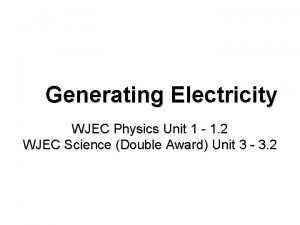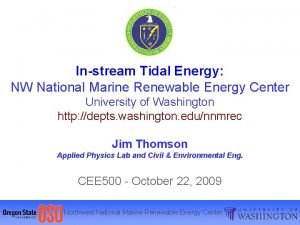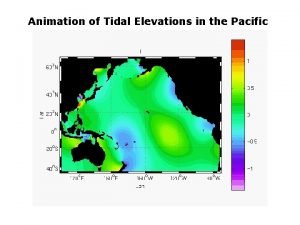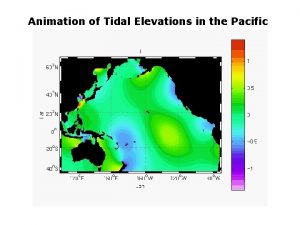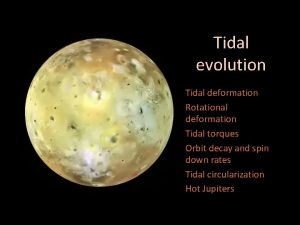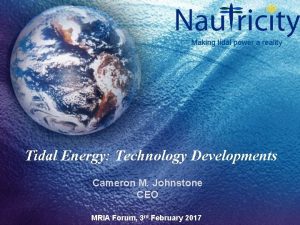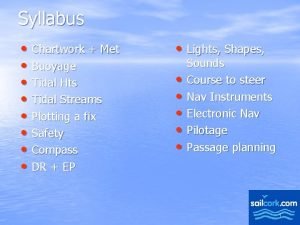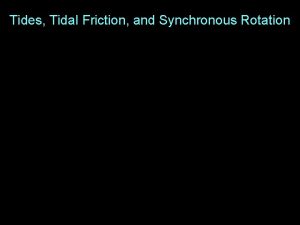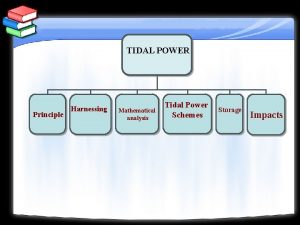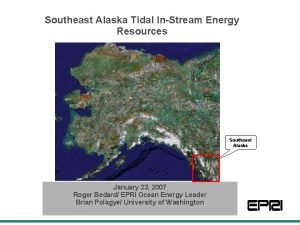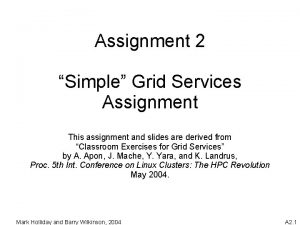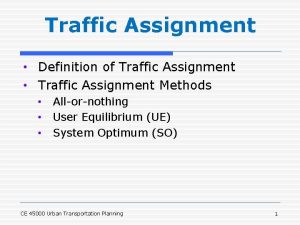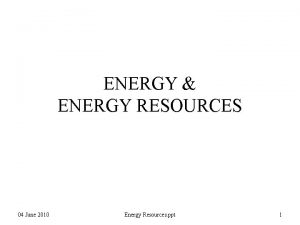Tidal Energy Ryan Saad Sufie Energy Resources Assignment






















- Slides: 22

Tidal Energy Ryan, Saad, Sufie Energy Resources Assignment SPH 3 U

What is Tidal Energy? • A type of hydropower that is used to generate electricity by converting the energy of tides into usable energy.

Tidal Stream Generators (TSGs) • Tidal Stream Generators make use of the kinetic energy of moving currents to turn turbines and power generators. • The amount of power generated by TSGs is dependent on the strength of the water current.

TSGs - Advantages • Constant streams of water currents allow a constant generation of electricity. • Highly efficient; TSGs convert about 80% of the kinetic energy of the water into electricity.

TSGs - Disadvantages • Difficult to install and maintain the underwater turbines. • Changes in tidal movement reduces efficiency. • Devices sometimes break down because of excessively strong water currents and sea water corrosion. • Floor mounting may disrupt habitats of sea life.

Types of TSGs • Horizontal Axis Turbines • Vertical Axis Turbines • Reciprocating Devices • Venturi Effect Tidal Stream Devices

Tidal Barrages • Dams that use the raising and receding tides and the potential energy involved. • When the tides rise, water flows from the sea into the basin of water that the dam is holding back. • When the tides recede, the water is released through gates of turbines, which power generators.

Tidal Barrages - Advantages • The tides are predictable because of the relation to the moon, thus making it a reliable source of renewable energy. • Barrages are not dependent on random weather patterns, unlike wind or solar energy. • It is a cheap energy source once the initial cost is paid off.

Tidal Barrages - Disadvantages • Fish and other marine life can be hurt or even killed by colliding into or going through the turbines; their movements or migrations could also be affected. • Limited suitable locations, needs good sized tides and large areas for the dam and the water retainment

Types of Tidal Barrages • Ebb Generation • Flood Generation • Two-Way Generation • Double Basin Tidal Generation

Dynamic Tidal Power (DTP) • An untried, proposed technology which involves building long wall-like dams straight out from the coasts of specific areas. • As waves hit the dams, strong coastal-parallel currents are created and can be captured and transformed into electricity through generators.

DTP - Advantages • A single dam can produce 8 to 15 gigawatts (8 to 15 billion watts) in an hour. • Very stable compared to other methods. • High availability, only requires a wide coast. • Potential for combined functions, such as with coastal protection.

DTP - Disadvantages • Unsure if the technology involved will be efficient or even successful, since it is not currently in use. • Can only be tested on a large scale, which could be expensive. • There is potential to negatively affect the environment and the ecosystem.

Tidal Lagoons • Tidal Lagoons are a newer design concept, involves building circular wall-dams that retain water, capture potential energy of the tides, and transform it into electricity using turbines and generators. • Similar to Tidal Barrages, but artificial location and no pre-existing ecosystem.

Tidal Lagoons - Advantages • Tidal Lagoons are reliable because of constant electricity generation and predictability. • Easy to combine with special pumps that use renewable energy to raise water levels, increasing energy production. • Dam could support potential local sports, such as walking, cycling and swimming.

Tidal Lagoons - Disadvantages • Higher cost due to large size and amount of resources needed. • Do not capture as much as water as the other methods, individually they create less energy. • Energy generation is significantly lower than other technology, such as wind- or tidal streamgenerated.

Application of Methods • Tidal Barrage; Rance Tidal Power Station in France, opened 1966 (World first and largest tidal power station until the one in Korea is installed). • Stream Generator; Seagen in Strangford Lough in the U. K. • Tidal Lagoon; Swansea Bay Project construction is scheduled for completion in U. K. by 2017

Tidal Energy Vs. Wind Energy • Tidal energy costs more to operate and construct the machines than wind energy. • Wind energy is unpredictable due to unstable weather conditions; tidal energy is completely predictable. • Water turbines produce much more electricity than wind turbines; Water turbines produce an average of 1, 824, 000 k. Wh per day, wind turbines produce an average of 14400 k. Wh per day. • Wind turbines create noise for people living nearby, and may harm birds and other wildlife.

Tidal Energy Vs. Solar Energy ● Initial cost of solar energy panels are cheaper than tidal energy devices. ● Weather patterns directly affect the efficiency of solar energy since solar panels depend solely on sunlight. Tidal energy produces more electricity, constantly. ● Solar panels require space on land to be built: the amount of space depends on the amount of panels. ● Solar energy produces pollution, Nitrogen trifluoride and sulfur hexafluoride… these greenhouse gases have an impact on global warming; tidal energy is pollution free.

Monetary Cost of Building a Tidal Project • Construction cost • There is a high capital cost for a tidal project, with a 5 to 7 year construction. Meanwhile, the high cost of engineering design, using large manpower. • The cost of one tidal turbine that converts 65 kw of power costs $4, 000. However, at the same time, it introduces job opportunities to complete construction which is good for the economy. • Maintenance A minimum lifespan of 120 years is estimated by engineers.

Environmental Impacts • A mortality of rate of fishes passing through a tidal barrage is 20% -80%. • Holding back the tide allows silt to build up in the river bed, reducing the water flow for years! • Disrupted fish migrate; may reduce the fish population in the oceans. • The noise pollution produced by the turbines.

Thank you for watching
 Tidal energy assignment
Tidal energy assignment Dr bridgett casadaban
Dr bridgett casadaban Tidal energy ltd
Tidal energy ltd Environmental impacts of tidal energy
Environmental impacts of tidal energy Tidal energy pros and cons
Tidal energy pros and cons Tidal energy pdf
Tidal energy pdf Tidal energy
Tidal energy Cominstream
Cominstream Tidal power animation
Tidal power animation Tidal energy animation
Tidal energy animation Klodia saad
Klodia saad Saad ahmed economics
Saad ahmed economics Is an extended erp module
Is an extended erp module Dr sadia saad
Dr sadia saad Saad ahmad md
Saad ahmad md Movie database
Movie database Télégestion saad
Télégestion saad Manufacturing strategies
Manufacturing strategies Joanne saad
Joanne saad Saad mohsen ٨- احذر احذر
Saad mohsen ٨- احذر احذر Salman azhar
Salman azhar Dr hussein saad
Dr hussein saad Saad alshahrani
Saad alshahrani





